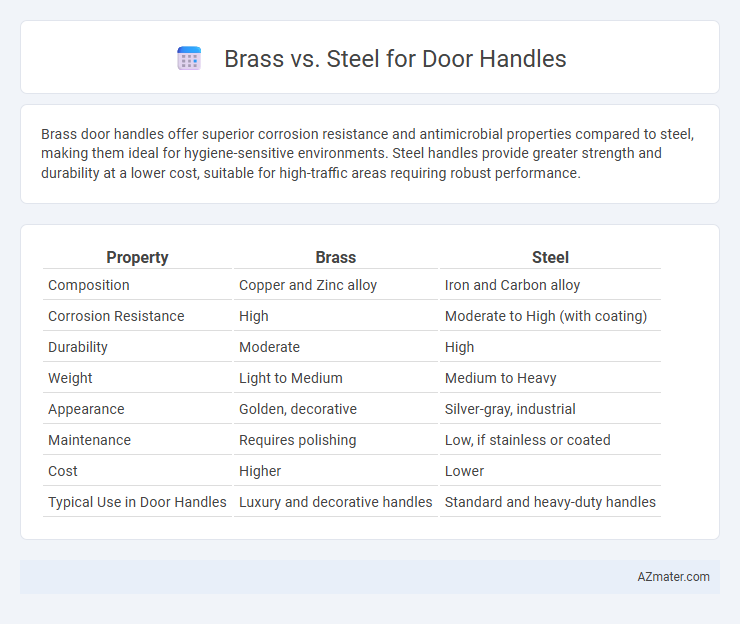Brass door handles offer superior corrosion resistance and antimicrobial properties compared to steel, making them ideal for hygiene-sensitive environments. Steel handles provide greater strength and durability at a lower cost, suitable for high-traffic areas requiring robust performance.
Table of Comparison
| Property | Brass | Steel |
|---|---|---|
| Composition | Copper and Zinc alloy | Iron and Carbon alloy |
| Corrosion Resistance | High | Moderate to High (with coating) |
| Durability | Moderate | High |
| Weight | Light to Medium | Medium to Heavy |
| Appearance | Golden, decorative | Silver-gray, industrial |
| Maintenance | Requires polishing | Low, if stainless or coated |
| Cost | Higher | Lower |
| Typical Use in Door Handles | Luxury and decorative handles | Standard and heavy-duty handles |
Introduction to Door Handle Materials
Brass and steel are two popular materials used for door handles, each offering distinct advantages in durability and aesthetics. Brass provides a classic appearance with natural antimicrobial properties and excellent resistance to corrosion, making it ideal for frequently touched surfaces. Steel, especially stainless steel, is favored for its high strength, modern look, and superior resistance to wear and rust, suitable for both residential and commercial door hardware.
Overview of Brass and Steel Door Handles
Brass door handles offer exceptional corrosion resistance, antimicrobial properties, and a classic aesthetic, making them ideal for both residential and commercial settings. Steel door handles, particularly stainless steel, provide superior strength, durability, and modern appeal, often used in high-traffic areas due to their resistance to wear and impact. Both materials vary in maintenance needs, with brass requiring occasional polishing to retain its luster, while steel benefits from easy cleaning and robust longevity.
Aesthetic Appeal: Brass vs Steel
Brass door handles provide a warm, golden hue that enhances traditional and vintage interiors with their rich, classic appearance and the natural patina they develop over time. Steel door handles offer a sleek, modern look with a cool, metallic finish that complements contemporary and industrial design styles, providing a minimalist and polished aesthetic. Choosing between brass and steel depends on whether the desired aesthetic is timeless elegance or clean, modern sophistication.
Durability and Strength Comparison
Brass door handles exhibit excellent corrosion resistance and maintain their aesthetic appeal over time, making them durable for indoor environments with moderate wear. Steel door handles, particularly those made from stainless steel, offer superior tensile strength and resistance to impact, ideal for high-traffic or external doors requiring robust security. Over prolonged use, steel outperforms brass in strength and resilience, while brass excels in resistance to tarnishing and requires less maintenance in non-abrasive settings.
Corrosion Resistance: Which Material Lasts Longer?
Brass exhibits superior corrosion resistance due to its natural alloy composition containing copper and zinc, which forms a protective oxide layer preventing rust. Steel, particularly stainless steel, offers good corrosion resistance but may rust if the protective chromium oxide layer is compromised or in harsh environments. Brass door handles generally last longer in outdoor and humid conditions, while steel requires more maintenance to prevent corrosion over time.
Maintenance Requirements for Brass and Steel
Brass door handles require regular polishing to prevent tarnishing and maintain their bright, golden appearance, as exposure to moisture and air causes oxidation. Steel door handles, especially stainless steel, demand less frequent maintenance but should be cleaned periodically to avoid rust and corrosion, particularly in humid or outdoor environments. Both materials benefit from using mild soap and water for cleaning, with brass needing occasional application of protective wax or lacquer for long-lasting shine.
Cost Analysis: Brass vs Steel Handles
Brass door handles typically cost more than steel handles due to the higher price of brass raw materials and its intricate casting processes. Steel handles offer a more budget-friendly option with strong durability, making them suitable for high-traffic areas or commercial applications. When factoring in maintenance and longevity, brass handles may justify their higher initial cost by resisting corrosion and maintaining appearance, while steel handles often require protective coatings to prevent rust and wear over time.
Safety and Hygiene Considerations
Brass door handles offer natural antimicrobial properties due to their copper content, reducing the risk of bacterial transmission and enhancing hygiene in high-touch areas. Steel handles, especially stainless steel, provide robust durability and resistance to corrosion but lack inherent antimicrobial effects, requiring frequent cleaning to maintain safety standards. Choosing brass supports improved infection control in public and healthcare settings, while steel remains preferred for its strength and maintenance ease.
Environmental Impact of Brass and Steel Production
Brass production involves the extraction of copper and zinc, both of which have significant environmental footprints due to mining operations that contribute to habitat destruction and energy-intensive smelting processes. Steel manufacturing, primarily reliant on iron ore, also demands substantial energy, often from coal-based sources, leading to high carbon emissions and air pollution. Recycling both metals reduces environmental impact, but steel benefits from a more established global recycling infrastructure, resulting in a comparatively lower carbon footprint over its lifecycle.
Brass vs Steel: Which Door Handle is Right for You?
Brass door handles offer excellent corrosion resistance and antimicrobial properties, making them ideal for high-traffic or humid environments, while steel handles provide superior strength and durability at a generally lower cost. Brass handles typically feature a warm, classic aesthetic that enhances traditional or vintage decor, whereas steel door handles suit modern, industrial designs with their sleek, minimalist appearance. Choosing between brass and steel depends on your priorities for style, maintenance, longevity, and budget considerations for door hardware.

Infographic: Brass vs Steel for Door Handle
 azmater.com
azmater.com